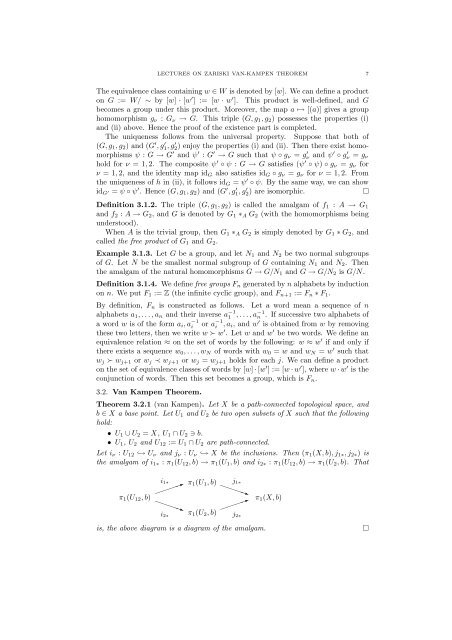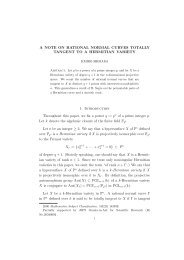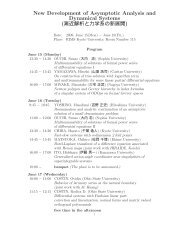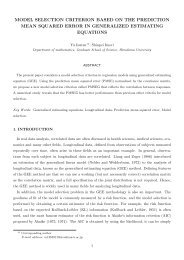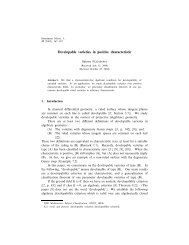LECTURES ON ZARISKI VAN-KAMPEN THEOREM 1. Introduction ...
LECTURES ON ZARISKI VAN-KAMPEN THEOREM 1. Introduction ...
LECTURES ON ZARISKI VAN-KAMPEN THEOREM 1. Introduction ...
You also want an ePaper? Increase the reach of your titles
YUMPU automatically turns print PDFs into web optimized ePapers that Google loves.
<strong>LECTURES</strong> <strong>ON</strong> <strong>ZARISKI</strong> <strong>VAN</strong>-<strong>KAMPEN</strong> <strong>THEOREM</strong> 7<br />
The equivalence class containing w ∈ W is denoted by [w]. We can define a product<br />
on G := W/ ∼ by [w] · [w ′ ] := [w · w ′ ]. This product is well-defined, and G<br />
becomes a group under this product. Moreover, the map a ↦→ [(a)] gives a group<br />
homomorphism g ν : G ν → G. This triple (G, g 1 ,g 2 ) possesses the properties (i)<br />
and (ii) above. Hence the proof of the existence part is completed.<br />
The uniqueness follows from the universal property. Suppose that both of<br />
(G, g 1 ,g 2 ) and (G ′ ,g 1,g ′ 2) ′ enjoy the properties (i) and (ii). Then there exist homomorphisms<br />
ψ : G → G ′ and ψ ′ : G ′ → G such that ψ ◦ g ν = g ν ′ and ψ ′ ◦ g ν ′ = g ν<br />
hold for ν =1, 2. The composite ψ ′ ◦ ψ : G → G satisfies (ψ ′ ◦ ψ) ◦ g ν = g ν for<br />
ν =1, 2, and the identity map id G also satisfies id G ◦ g ν = g ν for ν =1, 2. From<br />
the uniqueness of h in (ii), it follows id G = ψ ′ ◦ ψ. By the same way, we can show<br />
id G ′ = ψ ◦ ψ ′ . Hence (G, g 1 ,g 2 ) and (G ′ ,g 1,g ′ 2) ′ are isomorphic.<br />
Definition 3.<strong>1.</strong>2. The triple (G, g 1 ,g 2 ) is called the amalgam of f 1 : A → G 1<br />
and f 2 : A → G 2 , and G is denoted by G 1 ∗ A G 2 (with the homomorphisms being<br />
understood).<br />
When A is the trivial group, then G 1 ∗ A G 2 is simply denoted by G 1 ∗ G 2 , and<br />
called the free product of G 1 and G 2 .<br />
Example 3.<strong>1.</strong>3. Let G be a group, and let N 1 and N 2 be two normal subgroups<br />
of G. Let N be the smallest normal subgroup of G containing N 1 and N 2 . Then<br />
the amalgam of the natural homomorphisms G → G/N 1 and G → G/N 2 is G/N.<br />
Definition 3.<strong>1.</strong>4. We define free groups F n generated by n alphabets by induction<br />
on n. We put F 1 := Z (the infinite cyclic group), and F n+1 := F n ∗ F 1 .<br />
By definition, F n is constructed as follows. Let a word mean a sequence of n<br />
alphabets a 1 ,...,a n and their inverse a −1<br />
1 ,...,a−1 n . If successive two alphabets of<br />
a word w is of the form a i ,a −1<br />
i or a −1<br />
i ,a i , and w ′ is obtained from w by removing<br />
these two letters, then we write w ≻ w ′ . Let w and w ′ be two words. We define an<br />
equivalence relation ≈ on the set of words by the following: w ≈ w ′ if and only if<br />
there exists a sequence w 0 ,...,w N of words with w 0 = w and w N = w ′ such that<br />
w j ≻ w j+1 or w j ≺ w j+1 or w j = w j+1 holds for each j. We can define a product<br />
on the set of equivalence classes of words by [w] · [w ′ ]:=[w · w ′ ], where w · w ′ is the<br />
conjunction of words. Then this set becomes a group, which is F n .<br />
3.2. Van Kampen Theorem.<br />
Theorem 3.2.1 (van Kampen). Let X be a path-connected topological space, and<br />
b ∈ X a base point. Let U 1 and U 2 be two open subsets of X such that the following<br />
hold:<br />
• U 1 ∪ U 2 = X, U 1 ∩ U 2 ∋ b.<br />
• U 1 , U 2 and U 12 := U 1 ∩ U 2 are path-connected.<br />
Let i ν : U 12 ↩→ U ν and j ν : U ν ↩→ X be the inclusions. Then (π 1 (X, b),j 1∗ ,j 2∗ ) is<br />
the amalgam of i 1∗ : π 1 (U 12 ,b) → π 1 (U 1 ,b) and i 2∗ : π 1 (U 12 ,b) → π 1 (U 2 ,b). That<br />
π 1 (U 12 ,b)<br />
i 1∗<br />
✏ ✏✏ ✏✶<br />
<br />
<br />
i 2∗<br />
π 1 (U 1 ,b)<br />
π 1 (U 2 ,b)<br />
j 1∗<br />
<br />
<br />
✏ ✏✏ ✏✶<br />
j 2∗<br />
π 1 (X, b)<br />
is, the above diagram is a diagram of the amalgam.


